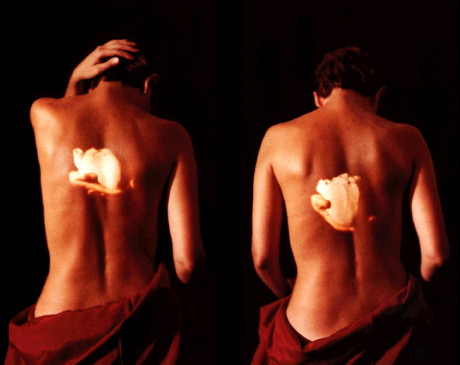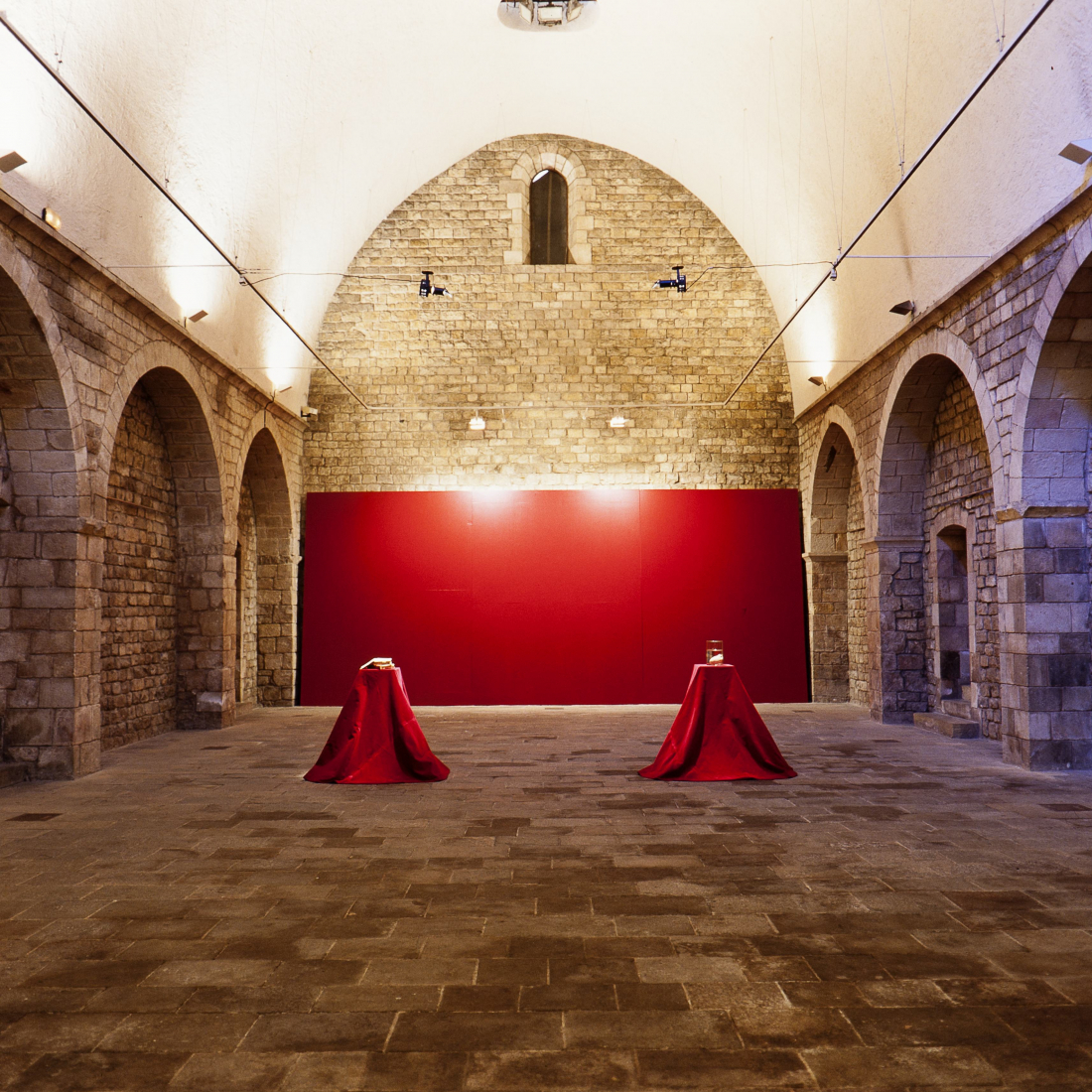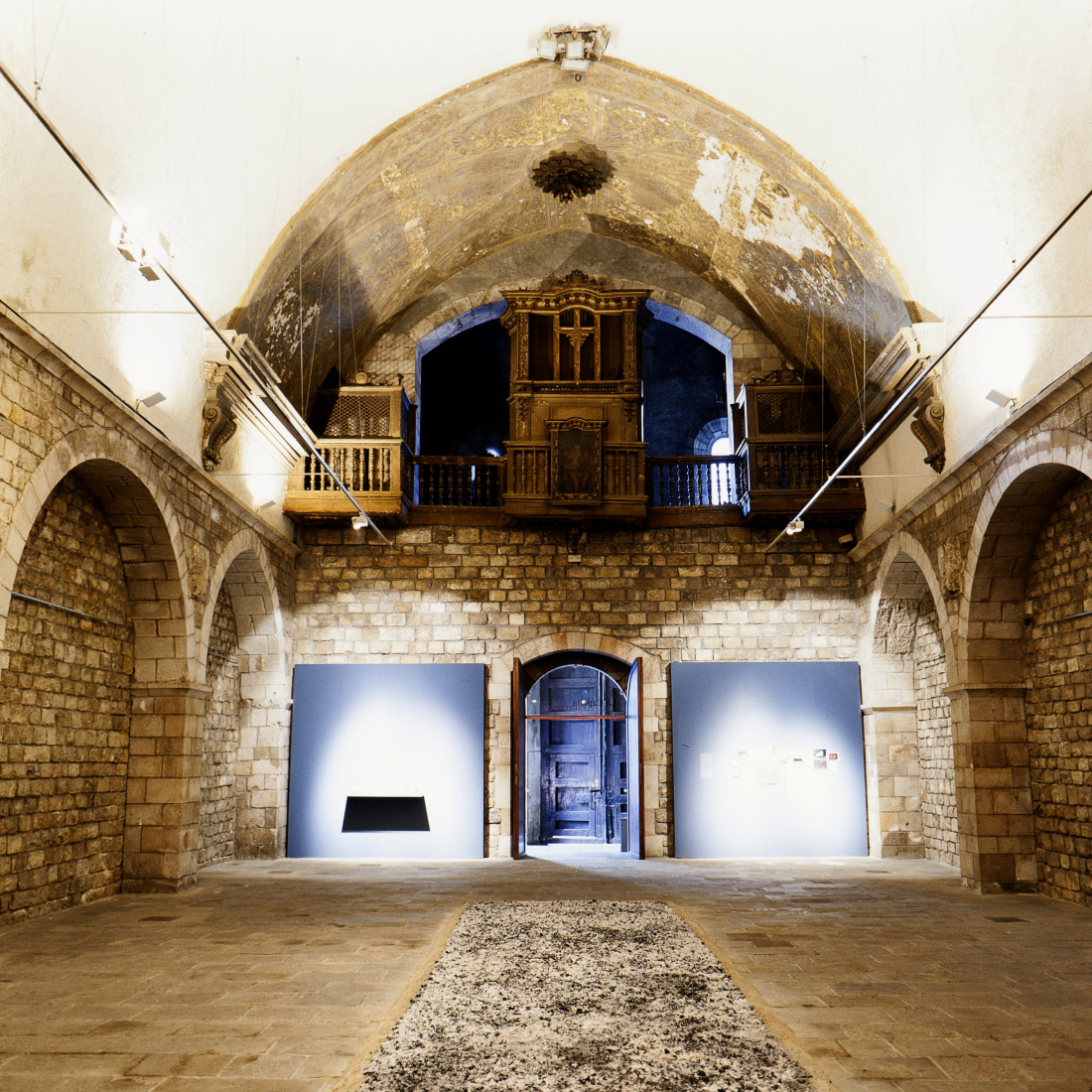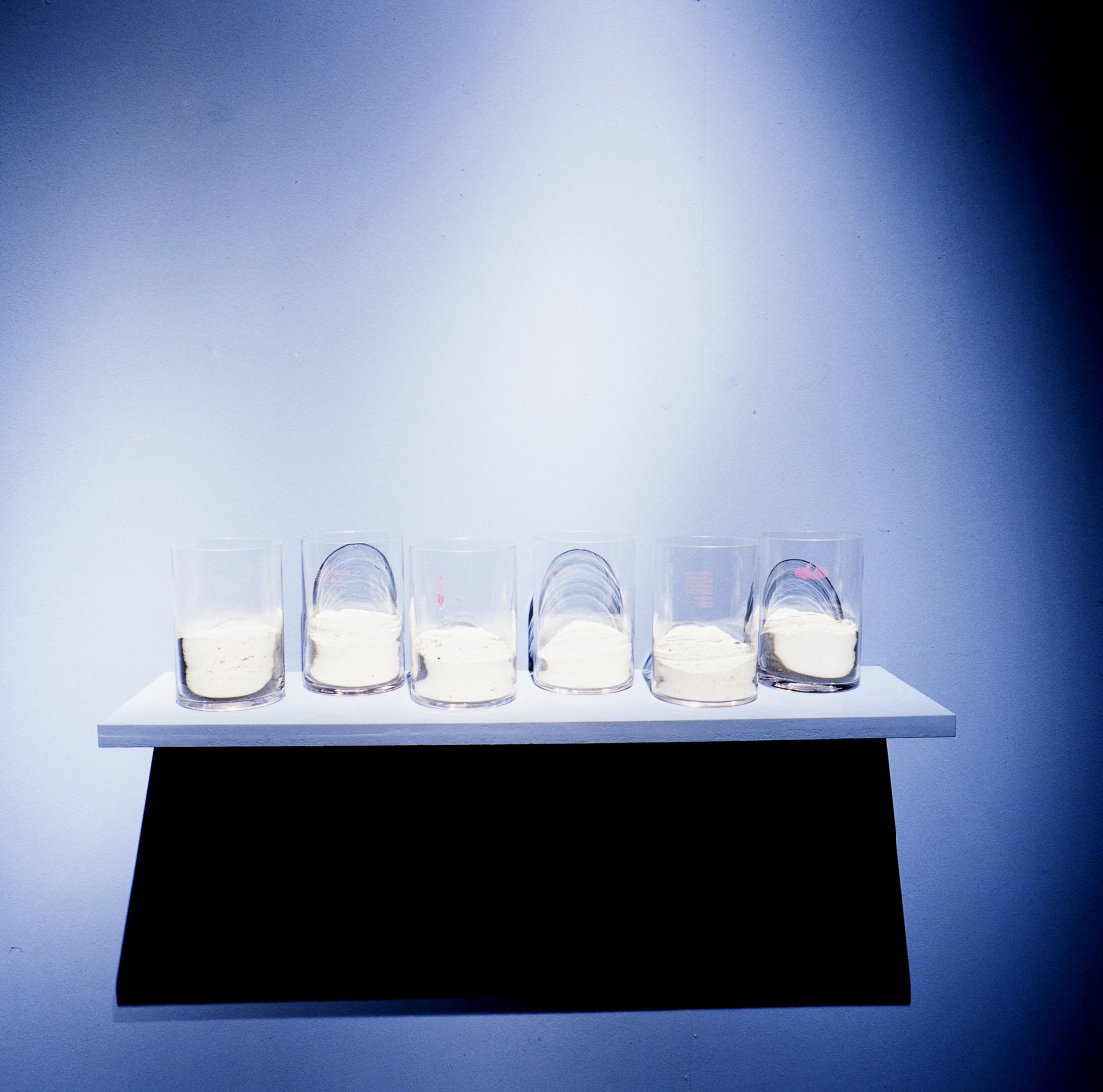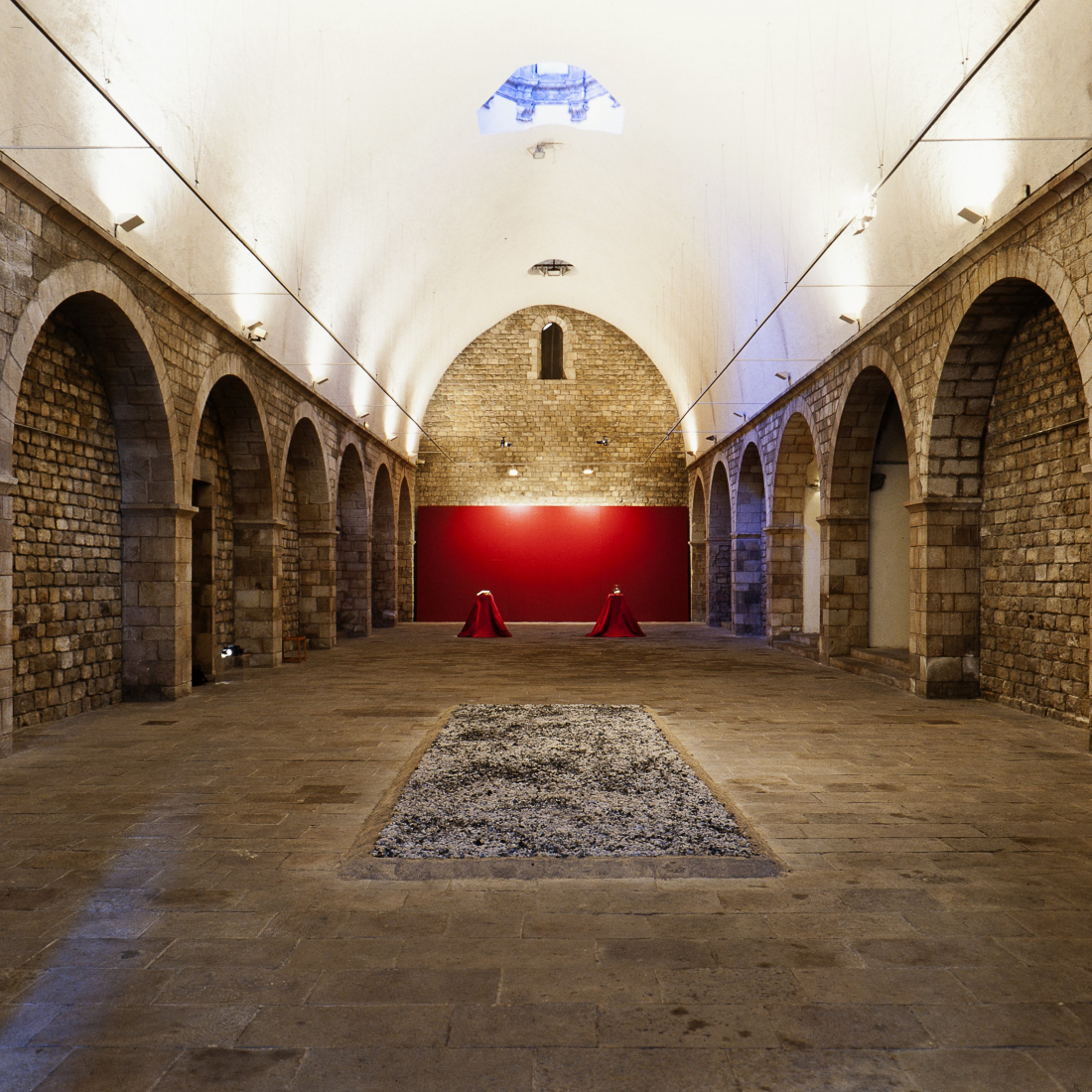El ave que rasga el pecho y da a comer sus entrañas por amor
<< Give to see >>, give way, give light
<< And so when in a moment you stay absolutely still it will open at par, giving itself whole. It is what dreams. Like everything enclosed, the heart dreams of escaping, like everything chained, getting rid of, even at the cost of tearing. Like everything that contains some prices, with spilling it out at once >>. María Zambrano.
<< This is in the blue of the word, blue to blue, still blue yet ... >> Joan Vinyoli
There are many aspects of Mirta Tocci's work that have been interested since I first saw it a few months ago and as I have been acquainted with it in visits to his studio. During this time, things have happened to me very curious and I would like to explain some, not as personal anecdotes, but as possible keys to this work to know, for example, where it begins and where it is going.
Not long ago, I moved to a new apartment with patio. The hibiscus in my garden leaves every morning the land encased with bright red flowers that bind themselves up to saturate themselves. I have looked carefully at it since Tocci taught me a similar flower encapsulated in a frame, the same that can be seen in this exhibition. Although it is very similar to Mirta, it is a << ginger flower >> and gave a title to the beautiful text that the critic Lebrero Stals wrote for the exhibition of the work that we now show expanded to La Capella with the name The bird that tears the chest and gives to eat its entrails by love.
When Mirta told me this title, I remembered the verses of the Libre de Amic. Songs by Abelone, poet Joan Vinyoli, my head reading for many years and an example of this writing where, as Segimon Serrallonga indicates in the prologue, the act of writing transfers the primordial experience of being. In these poems, the image of the bird is very present: in the form of << alosa >> shakespeariana, of << hawk >> (which, as noted in Serrallonga, is a very current image in medieval literature and in the mystical) and of "the invisible bird" that inhabits and vivifies the spirit and the word of the poet. The intensity of the act of love that evokes the title of Tocci's work is also one of the fundamental themes of this Vinyoli book that pays homage to Ramon Llull and R.M. Rilke. In these poems the symbolic images of an essential communion are frequent, understood as an experience of communication and as a celebration of singing, a writing that expresses the deep voice.
Colette's ring (the Colette ring), framed picture present also in this exhibition, also belongs to the imagery of this << get rid of full >>. I had never seen him before the artist showed me and explained to me the Irish legend that makes him an alliance of commitment and desire for love. Do not believe me if I tell you that a few days ago, in the subway in Barcelona, I saw this ring, as in an appearance, at the hand of a traveler who was leaning against the door of the wagon.
Perhaps these three paragraphs are sufficient to indicate that there is something in this work that works by coinciding in time and space, linking experiences, causing chainings. To find out if these leads them to three notions escape, in one way or another, to the control of a faint logos.
First of all, these personal revelations interested me to emphasize that the images that Tocci selects, combines and creates they flee from abstraction and insist on launching our gaze back to the world, towards the experience that we ourselves have, With such power that, if you are aware, this return is configured as an initiatory journey that leads us even where we have not thought of going. The world becomes a great open book (as for the Renaissance humanists) through which our curious look runs. And, on the one hand, as Tocci says, his images are firing, on the other, we suggest them as sponges, able to absorb and fill to such an extent that we can feel dripping.
To continue the approach to this work, I have to clarify that when I speak of images I mean all kinds of elements: objects -constructed and natural-, written, cut-outs, postcards, drawings, photographs, projections ... even to an action. When naming them << images >> I do not want to indicate their way of presenting themselves but their common nature of signs. It is important to keep in mind that the artist uses these elements, always preserving their corporeality and their way of meaning. I would like to approach this work in these terms: as an image of images that, moreover, is lacking in form (fixed boundary). That is to say, this work -which can not be called proper installation- can also grow as unpredictably as the images we are talking about do for us. What I want to say is that the work << is like this and it could be otherwise >>, nor that it is ephemeral or unfinished. I want to point out a state of constant gestation that in addition to a way of working (processual) defines, in fact, a certain dimension of language.
Secondly, another fascinating aspect of this work is that it is born in the natural confluence of looking and reading, in the best pre-enlightened tradition of << knowing by image >>. We observe, as it originates in a path of scrubs, burning bed, metaphor of living, how to crepit and how to consume (during the exhibition, the Roman storm path as a path of ashes). From this vertebral axis, two disjunctive paths that at the same time are prolongations of this vital center are presented in the route. Both options lead us to images of the heart: on a pedestal, a manual of ancient anatomy describes it in scientific language and shows the drawing. On another pedestal, at the same height and distance from the path, a transparent container contains a replica made from the natural one of a woman's heart.
In this way, the language of this work is configured as a way of giving it to see. If we look closely, we will realize that the offer and delivering action is very present in this work, not only as a topic but also in various aspects of its grammar. For example, the dramatization of light on objects does not intend to dramatize staging but emphasize the act of showing. The images of this work seem to acquire meaning in being offered to be << image read >>, the starting point of our journey. A way of communicating that perhaps is closer to the tradition of emblems, loci compositions, and the theaters of memory, particular forms of discourse, now lost, that organically related the iconic and linguistic sign with the ultimate purpose of revealing the essences of the world. A kingdom of images that has nothing to do with that of allegories or the language of advertising.
There is no single reading key to decipher its hidden meanings. If we decode them, these images can be left between the unfocused hands, as simple deflated. As Serrallonga indicates about the language of Vinyoli, that of Tocci invites us to << participate in the mystery as a mystery (not to elucidate it) >>. The best, in these cases, is to let yourself be carried away by the voracity of the look (of the writing) and let you commit acts of anthropophagy (to somatize the image). Get started, dive into its cavernous interiors where these images open as tunnels ramifying into multiple galleries. In the same way that in the engravings of the << theaters of memory >> the message is not translated but is pursued, following a few lines of reading, in multiple directions and routes, in this work the discourse becomes what the " writer Ana Martínez-Collado calls an "infinite narration".
From here, we cross the border that separates the pole from the real space of the virtual space plan and we enter into the field of polyphony, intertextuality, tranterritoris, permeability. The connections between real and mental experience accelerate as in the best of virtual games, with the added advantage that, as the network grows, the meaning of the discourse is drawn. A speech, which, in a fabric, is framed with what is biographical to leave the work without attacking and the sack also begun on the other side. Analogies, synestheses, ideas associations, synchrony ... Latency of a world that flows inside and inside, zigzagging us as if you are going through a mined field. Images that would look like Norman Bryson, referring to the "transposed signs" (sign transfers) of the emblems, called "empathic" because they give way to the viewer << as a presence that is 'embodies' in the space of representation and passes through the temporal and stereoscopic dimension that this coagulates.
By these characteristics, I also suspect that these images are related to << imago >> (internal representations). The most recent works by Tocci (which are not in the exhibition but which we reproduce in the catalog) are photographs that present an image projected into the artist's scheme, as if it were an innate, engraved, printed image, in the key of the neplatonic aesthetics.
The heart, the zenith light, the darkness, the flames, the heat, the coats, the ashes are symbolic images and, beyond, are also those metaphors that, as Maria Zambrano says, we locate << at the base of culture> >. Its origin seems to be not at the beginning of all time. If, on the one hand, Tocci emphasizes the symbolic dimension of language, language as a container << that is invisible given the measure that is indispensable >>, such as giving it to see, on the other hand, this work seems to recover the fertility of These metaphors that keep the thread of speech from this historical principle and act as muscles in sudden contractions about to give birth.
But what happens when these representations appear on the body of women? What adds the genre to the reading of this habitat inhabited by signs that this image is? Parallel to that of Tocci, I remember an interesting work by artist Ana Mauri entitled Transida de Historia. In both, the body of the same artists is a reflective screen of the shapes and skin crossed by the symbolic dimension that these carry. The images, considered as forms, appear in all their immaterial nature, but taken as figures weigh, they are materialized in the density that confers their historical origin. In this sense I remember one of the last works of the American artist Hanna Wilke, already disappeared. His ill-treated face for cancer therapy seems to be overwhelmed by experience (pain or transposition) that comes from something deeper than his illness. His eyes closed seem to see in and out. His portrait seems to become the Pietà one.
These dimensions of the image that I pointed out in the reading of Tocci's work coincide in rejecting an empty gaze, that which survives abulica in the jungle of a culture of communication, which is nothing more than a dictatorship of codified signs and of Prefixed meanings, designed to reduce our experience of reality. By recalling the evocative power of essential language and metaphors, Mirta Tocci seems to emphasize a way to situate himself in the world and to know what restores the fullest sense of communication.
The two photographs that cover the catalog insist on this power of the image as a window that invites them to pour it. Behind us, we hear the noise of thousands of shutters that open and close in both directions, hinges of hinges and a continuous sound of steps: maze of dry blows and slight footprints.



